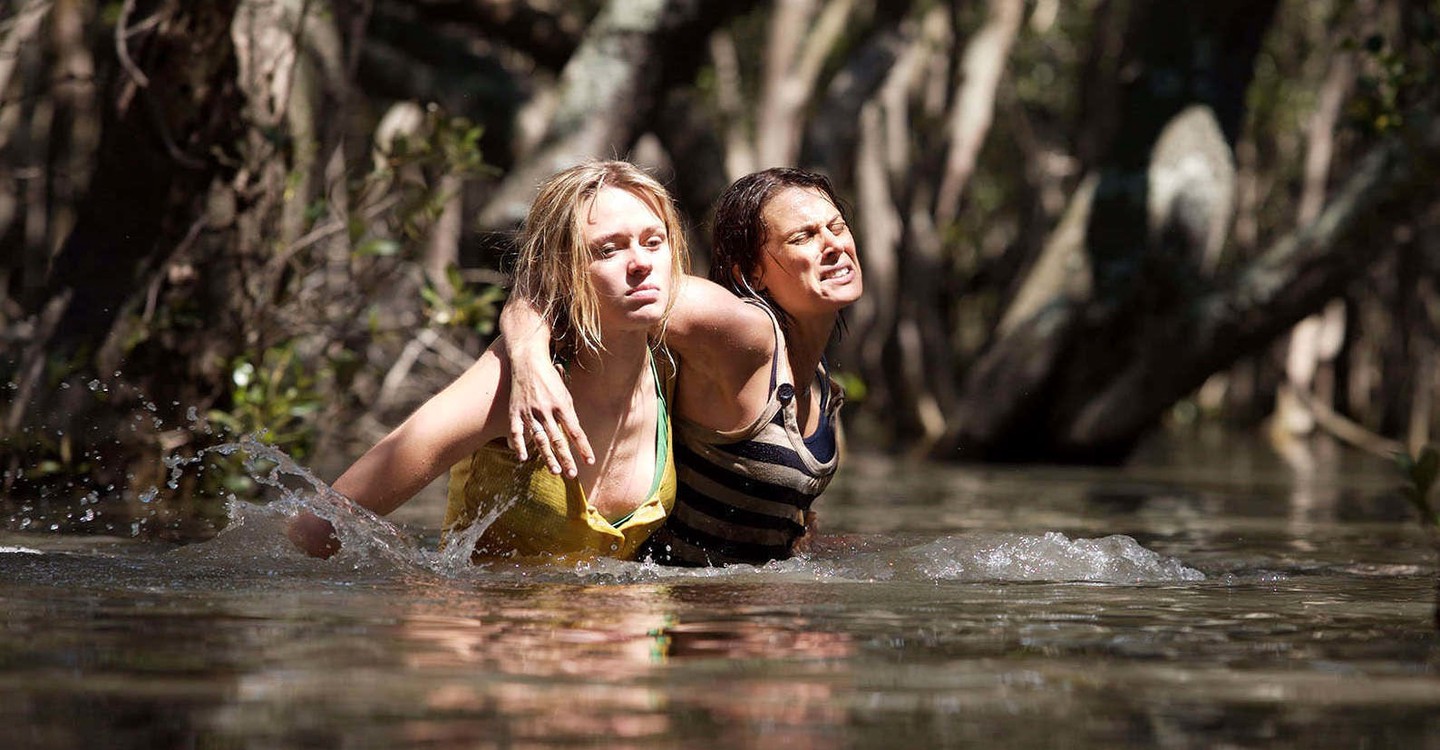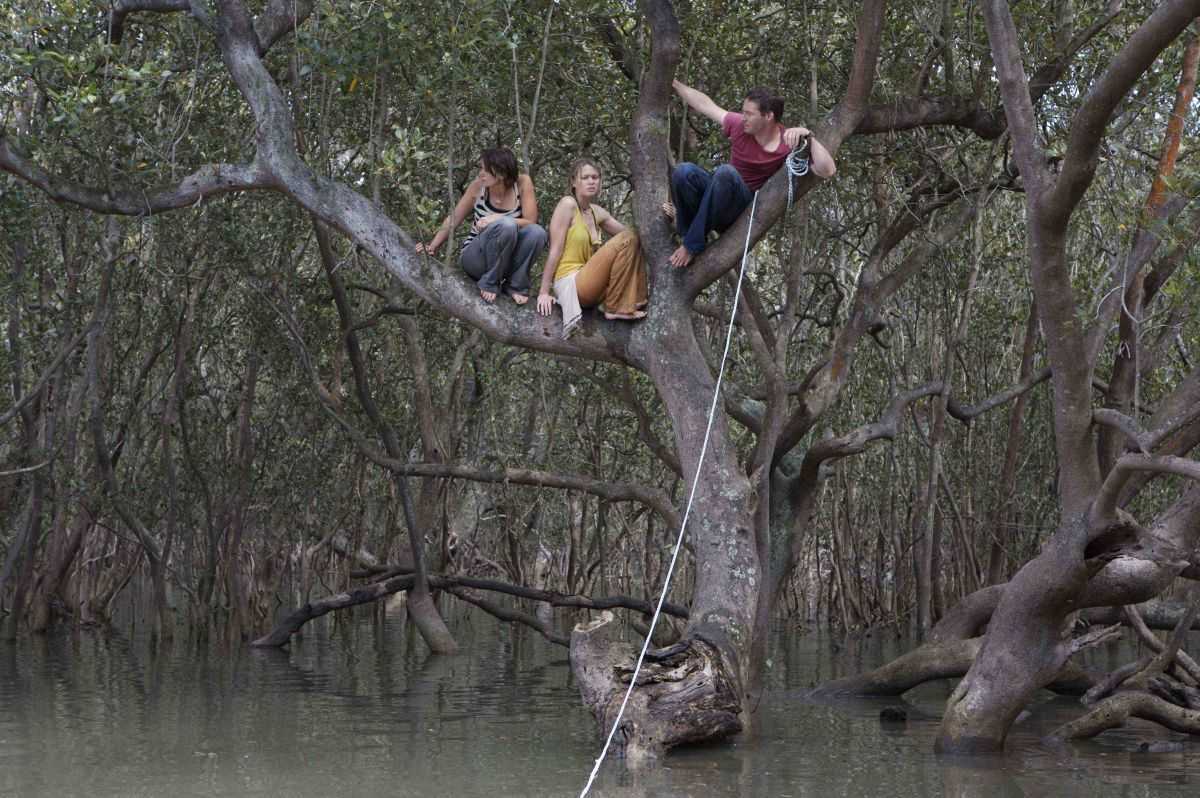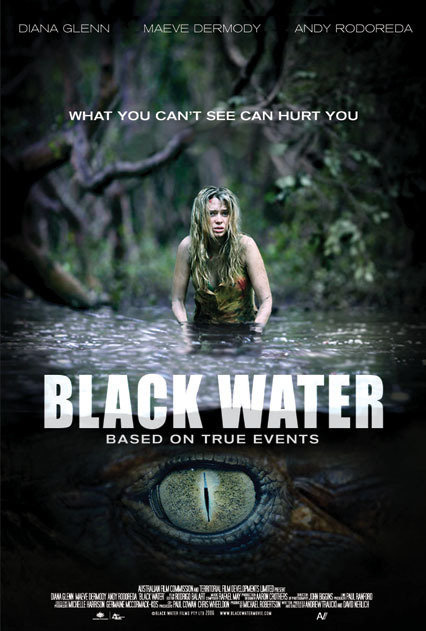Australia. 2007.
Crew
Directors/Screenplay – David Nerlich & Andrew Traucki, Producers – David Nerlich, Michael Robertson & Andrew Traucki, Photography – John Biggins, Music – Rafael May, Visual Effects – David Nerlich, Special Effects – Simon Way, Prosthetic Effects – Make-Up Effects Group (Paul Katto & Nick Nicolaou), Production Design – Aaron Crothers. Production Company – Australian Film Commission/Territorial Film Developments/Black Water Films Pty Ltd.
Cast
Maeve Dermody (Lee), Diana Glenn (Grace), Andy Rodoreda (Adam), Ben Oxenbould (Jim)
Plot
Adam, his girlfriend Grace and her sister Lee go on holiday in Australia’s Northern Territories. They decide to take a fishing tour in the backwaters of the mangrove swamps. As they stop in a bayou, their small boat is abruptly attacked and overturned by a crocodile. The tour guide is killed and the three of them are forced to get out of the water and take shelter in a tree. Realising that nobody knows where they are, they try to make an escape but have to find a way past the crocodile that lurks waiting in the water below.
Variously, films in one year coincide on a theme, usually in the attempt to exploit the perceived success of another film. In 2007, one of the peculiarities was a fad for killer crocodile films. The US produced the big budget Primeval (2007), which was in fact the least interesting entry in the fad, and there were various cheapie efforts such as Croc (2007), Lake Placid 2 (2007) and Supercroc (2007). On the other hand, Australia, which has a high crocodile native population, produced the two best entries among the fad with Greg McLean’s high profile Rogue (2007) and the much more modest, near identical and less celebrated Black Water here.
There are a considerable number of similarities between Rogue and Black Water. Both have very similar plots about a group of tourists from the city who are attacked by crocodiles in remote Australian backwaters where the characters are then forced to seek shelter on a precarious natural vantage point that is surrounded by water as the crocodile lurks all around. There are also a number of differences between the two. Rogue went to shoot in Australia’s remote Northern Territories, areas the production crew claimed that no filmmaker had ever ventured into before, whereas Black Water shot in Gungah Bay, which is merely a suburb of Sydney, the largest city in Australia. Rogue was shot for widescreen, taking in all the picture postcard views, whereas Black Water is shot with handheld digital camerawork; where Rogue was stylishly suspenseful, Black Water comes with more of a torturous realism. Rogue was cast with star names, clearly in an effort to carry it to international audiences, whereas Black Water features actors unknown outside of Australia. Rogue featured an elaborate animatronic crocodile, whereas the much lower-budgeted Black Water ingeniously uses real crocodiles that were filmed in a zoo and digitally pasted in.
The other film that Black Water reminds of somewhat is Open Water (2003) in its sense of a gruelling real world survival story – in comparison, Rogue felt like it was drawing more from the suspense driving strategies patented by Jaws (1975). Like Open Water, which was an entire film concerning two people at water in the sea and had no sets, Black Water has been made without any sets – the entire film consists of three people trapped in a tree.

Directors David Nerlich and Andrew Traucki, both newcomers, launch into the film with relentless suspense. The stripped minimalism of the exercise is something that reduces the dropping of a can of bug spray, of crawling between two trees into a tension fraught exercise. Scenes like Maeve Dermody’s fight to get out from underneath the overturned boat and then her frenzied climb to get to the tree; or where she tries to unobtrusively venture through the water to get to the drifting boat when in mid-journey the crocodile suddenly surfaces in front of her come with a nerve-racking tension that has one on the edge of their armchair.
Nerlich and Traucki create a sense of lurking danger at all times. Like Jaws, we do not see much of the crocodile – often it is represented by no more than a wake of moving water. Although in the scene when it emerges out of the water with a body in its mouth, it looks a remarkably evil-seeming creation. The one scene that nearly makes everyone watching poop their pants is the one where Diana Glenn is edging along a tree branch some 2-3 metres off the ground and the crocodile jumps up out of the water into the air to snatch at her. It has a wild unexpected jump that holds a superb out of the blue fright to it.
One of the most remarkable aspects about Black Water is the means by which it was made. Although the filmmakers only went to suburban Sydney, the locations look authentically like the Northern Territories. Due to the tidal conditions, most of the water drained out of the area during the daytime and there were only three hours of each day where they were able to film the tree with the actors surrounded by water. All of the visual effects for the film were conducted by David Nerlich on his laptop and were achieved by shooting real crocodiles in a zoo and green screening them into the action with the actors. The results work so seamlessly that one was surprised to learn that the actors were not reacting with animatronics or real crocodiles that were present in front of them.

Even though the film is shot with raw handheld digital camera, Nerlich and Traucki manage to fill it with some stunning shots of the slickness of the water or of insects flitting on its surface. There is one superb scene where Diana Glenn makes her trek through the warren of trees and comes to an impassably wide river and looks up to see the contrail of a jet far above in the sky, which suddenly becomes a perfect symbol of the near unreachability of the other side of the river from where she is.
Andrew Traucki on his own later made a sequel Black Water: Abyss (2020) with a different group being menaced by a crocodile.
Subsequently, Andrew Traucki went on on his own to make The Reef (2010), a similar film about a shark terrorising people stranded at sea; the G is for Gravity segment of The ABCs of Death (2012); The Jungle (2013), a Found Footage film about a film crew being stalked by a predator; and The Reef: Stalked (2022), a sequel in name only to his earlier film. David Nerlich has subsequently gone on to work in visual effects.
(Nominee for Best Directors (David Nerlich & Andrew Traucki) and Best Cinematography at this site’s Best of 2007 Awards).
Trailer here


